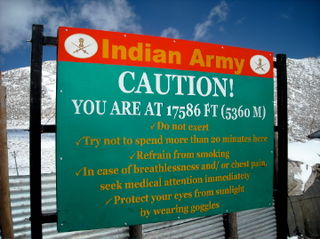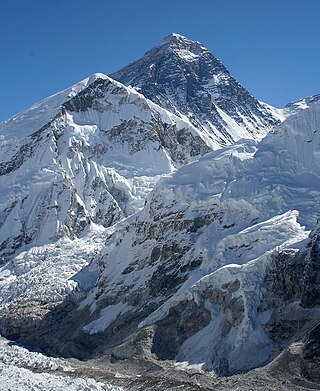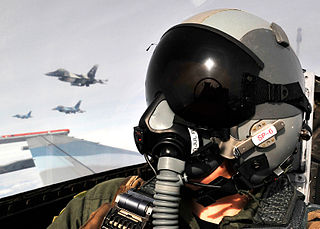Related Research Articles

Hypoxia is a condition in which the body or a region of the body is deprived of adequate oxygen supply at the tissue level. Hypoxia may be classified as either generalized, affecting the whole body, or local, affecting a region of the body. Although hypoxia is often a pathological condition, variations in arterial oxygen concentrations can be part of the normal physiology, for example, during strenuous physical exercise.

The respiratory system is a biological system consisting of specific organs and structures used for gas exchange in animals and plants. The anatomy and physiology that make this happen varies greatly, depending on the size of the organism, the environment in which it lives and its evolutionary history. In land animals the respiratory surface is internalized as linings of the lungs. Gas exchange in the lungs occurs in millions of small air sacs; in mammals and reptiles these are called alveoli, and in birds they are known as atria. These microscopic air sacs have a very rich blood supply, thus bringing the air into close contact with the blood. These air sacs communicate with the external environment via a system of airways, or hollow tubes, of which the largest is the trachea, which branches in the middle of the chest into the two main bronchi. These enter the lungs where they branch into progressively narrower secondary and tertiary bronchi that branch into numerous smaller tubes, the bronchioles. In birds the bronchioles are termed parabronchi. It is the bronchioles, or parabronchi that generally open into the microscopic alveoli in mammals and atria in birds. Air has to be pumped from the environment into the alveoli or atria by the process of breathing which involves the muscles of respiration.

Altitude sickness, the mildest form being acute mountain sickness (AMS), is the harmful effect of high altitude, caused by rapid exposure to low amounts of oxygen at high elevation. People can respond to high altitude in different ways. Symptoms may include headaches, vomiting, tiredness, confusion, trouble sleeping, and dizziness. Acute mountain sickness can progress to high-altitude pulmonary edema (HAPE) with associated shortness of breath or high-altitude cerebral edema (HACE) with associated confusion. Chronic mountain sickness may occur after long-term exposure to high altitude.

Lung volumes and lung capacities refer to the volume of air in the lungs at different phases of the respiratory cycle.

Pulmonary edema, also known as pulmonary congestion, is excessive liquid accumulation in the tissue and air spaces of the lungs. It leads to impaired gas exchange and may cause hypoxemia and respiratory failure. It is due to either failure of the left ventricle of the heart to remove oxygenated blood adequately from the pulmonary circulation, or an injury to the lung tissue directly or blood vessels of the lung.
The control of ventilation is the physiological mechanisms involved in the control of breathing, which is the movement of air into and out of the lungs. Ventilation facilitates respiration. Respiration refers to the utilization of oxygen and balancing of carbon dioxide by the body as a whole, or by individual cells in cellular respiration.

The carotid body is a small cluster of chemoreceptor cells, and supporting sustentacular cells. The carotid body is located in the adventitia, in the bifurcation (fork) of the common carotid artery, which runs along both sides of the neck.

In mountaineering, the death zone refers to altitudes above a certain point where the pressure of oxygen is insufficient to sustain human life for an extended time span. This point is generally tagged as 8,000 m. The concept was conceived in 1953 by Edouard Wyss-Dunant, a Swiss doctor, who called it the lethal zone. All 14 peaks above 8000 m in the death zone are located in the Himalaya and Karakoram of Asia.

Generalized hypoxia is a medical condition in which the tissues of the body are deprived of the necessary levels of oxygen due to an insufficient supply of oxygen, which may be due to the composition or pressure of the breathing gas, decreased lung ventilation, or respiratory disease, any of which may cause a lower than normal oxygen content in the arterial blood, and consequently a reduced supply of oxygen to all tissues perfused by the arterial blood. This usage is in contradistinction to localized hypoxia, in which only an associated group of tissues, usually with a common blood supply, are affected, usually due to an insufficient or reduced blood supply to those tissues. Genralized hypoxia is also used as a synonym for hypoxic hypoxia This is not to be confused with hypoxemia, which refers to low levels of oxygen in the blood, although the two conditions often occur simultaneously, since a decrease in blood oxygen typically corresponds to a decrease in oxygen in the surrounding tissue. However, hypoxia may be present without hypoxemia, and vice versa, as in the case of infarction. Several other classes of medical hypoxia exist.

Altitude training is the practice by some endurance athletes of training for several weeks at high altitude, preferably over 2,400 metres (8,000 ft) above sea level, though more commonly at intermediate altitudes due to the shortage of suitable high-altitude locations. At intermediate altitudes, the air still contains approximately 20.9% oxygen, but the barometric pressure and thus the partial pressure of oxygen is reduced.

Respiratory acidosis is a state in which decreased ventilation (hypoventilation) increases the concentration of carbon dioxide in the blood and decreases the blood's pH.
Hypoxic pulmonary vasoconstriction (HPV), also known as the Euler-Liljestrand mechanism, is a physiological phenomenon in which small pulmonary arteries constrict in the presence of alveolar hypoxia. By redirecting blood flow from poorly-ventilated lung regions to well-ventilated lung regions, HPV is thought to be the primary mechanism underlying ventilation/perfusion matching.

Hypoxemia is an abnormally low level of oxygen in the blood. More specifically, it is oxygen deficiency in arterial blood. Hypoxemia has many causes, and often causes hypoxia as the blood is not supplying enough oxygen to the tissues of the body.

The Armstrong limit or Armstrong's line is a measure of altitude above which atmospheric pressure is sufficiently low that water boils at the normal temperature of the human body. Exposure to pressure below this limit results in a rapid loss of consciousness, followed by a series of changes to cardiovascular and neurological functions, and eventually death, unless pressure is restored within 60–90 seconds. On Earth, the limit is around 18–19 km above sea level, above which atmospheric air pressure drops below 0.0618 atm. The U.S. Standard Atmospheric model sets the Armstrong pressure at an altitude of 63,000 feet (19,202 m).

2,3-Bisphosphoglyceric acid (2,3-BPG), also known as 2,3-diphosphoglyceric acid (2,3-DPG), is a three-carbon isomer of the glycolytic intermediate 1,3-bisphosphoglyceric acid (1,3-BPG).
A pulmonary shunt is the passage of deoxygenated blood from the right side of the heart to the left without participation in gas exchange in the pulmonary capillaries. It is a pathological condition that results when the alveoli of parts of the lungs are perfused with blood as normal, but ventilation fails to supply the perfused region. In other words, the ventilation/perfusion ratio of those areas is zero.

The effects of high altitude on humans are mostly the consequences of reduced partial pressure of oxygen in the atmosphere. The oxygen saturation of hemoglobin determines the content of oxygen in blood. After the human body reaches around 2,100 metres (6,900 ft) above sea level, the saturation of oxyhemoglobin begins to decrease rapidly. However, the human body has both short-term and long-term adaptations to altitude that allow it to partially compensate for the lack of oxygen. There is a limit to the level of adaptation; mountaineers refer to the altitudes above 8,000 metres (26,000 ft) as the death zone, where it is generally believed that no human body can acclimatize. At extreme altitudes, the ambient pressure can drop below the vapor pressure of water at body temperature, but at such altitudes even pure oxygen at ambient pressure cannot support human life, and a pressure suit is necessary. A rapid depressurisation to the low pressures of high altitudes can trigger altitude decompression sickness.
The Alveolar–arterial gradient, is a measure of the difference between the alveolar concentration (A) of oxygen and the arterial (a) concentration of oxygen. It is a useful parameter for narrowing the differential diagnosis of hypoxemia.
Hypoxic ventilatory response (HVR) is the increase in ventilation induced by hypoxia that allows the body to take in and transport lower concentrations of oxygen at higher rates. It is initially elevated in lowlanders who travel to high altitude, but reduces significantly over time as people acclimatize. In biological anthropology, HVR also refers to human adaptation to environmental stresses resulting from high altitude.

Breathing is the process of moving air into and from the lungs to facilitate gas exchange with the internal environment, mostly to flush out carbon dioxide and bring in oxygen.
References
- ↑ GUYTON, A.C., HALL, J.E "Tratado De Fisiologia Médica" 10. Ed. Rj . Elsevier Saunders: 2011;527
- ↑ GUYTON, A.C., HALL, J.E "Tratado De Fisiologia Médica" 10. Ed. Rj . Elsevier Saunders: 2011; 527
- 1 2 3 GUYTON, A.C., HALL, J.E "Tratado De Fisiologia Médica" 10. Ed. Rj . Elsevier Saunders: 2011; 528
- ↑ GUYTON, A.C., HALL, J.E "Tratado De Fisiologia Médica" 10. Ed. Rj . Elsevier Saunders: 2011;528
- ↑ GUYTON, A.C., HALL, J.E "Tratado De Fisiologia Médica" 10. Ed. Rj . Elsevier Saunders: 2011;531
- ↑ BORON, Walter. Et al. "Medical Physiology" 3 ed. España. Elsevier Saunders: 2012; 220
- ↑ BORON, Walter. Et al. Medical Physiology 3 ed. España. Elsevier Saunders: 2012; 224
- 1 2 BEST &TAYLOR. Bases fisiológicas de la práctica médica. 11 ed. España. gElservier Saunders: 2006; 230
- 1 2 BEST &TAYLOR. Bases fisiológicas de la práctica médica. 11 ed. España. gElservier Saunders: 2006; 228
- ↑ DOUGLAS, C. R. Tratado De Fisiologia Aplicada As Ciencias Da Saude. 5 Ed. Sp. Robe Ed Belman Ed. Imp. Exp. 2002.
- ↑ BORON, Walter. Et al. Medical Physiology 3 ed. España. Elsevier Saunders: 2012;221
- ↑ BORON, Walter. Et al. Medical Physiology 3 ed. España. Elsevier Saunders: 2012; 223
- ↑ GUYTON, A.C., HALL, J.E "Tratado De Fisiologia Médica" 10. Ed. Rj . Elsevier Saunders: 2011; 530
- ↑ GUYTON, A.C., HALL, J.E "Tratado De Fisiologia Médica" 10. Ed. Rj . Elsevier Saunders: 2011; 532